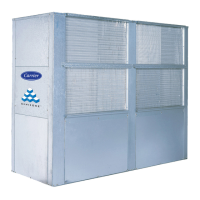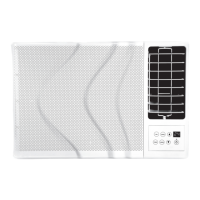38
TROUBLESHOOTING
Refer to Table 23 to determine the possible cause of the problem
and the associated procedure necessary to correct it. See Fig. 25-
30 for typical wiring schematics.
Table 23 — Troubleshooting Procedure
LEGEND
PROBLEM POSSIBLE CAUSE CORRECTION PROCEDURE
Unit Will Not Start
Loss of unit power
Check power source.
Check fuses, circuit breakers, disconnect switch.
Check electrical contacts.
Unit voltage not correct Check and correct.
Open fuse Check for short circuit in unit.
Open protection device Check relays, contacts, pressure switches.
Unit or motor contactor out of order Test and replace if necessary.
Fan Does Not Operate
Contactor or relay overload or out of order Test and replace if necessary.
Motor defective Test and replace if necessary.
Broken belt Replace belt.
Loose electrical contact Tighten contact.
Compressor is Noisy, but
Will Start
Under voltage Check and correct.
Defect in compressor motor Replace compressor.
Missing phase Check and correct.
Compressor seized Check and replace if necessary.
Compressor Starts, but
Does Not Continue to Run
Compressor or contact defect Test and replace if necessary.
Unit is not properly charged Check and correct any leaks. Adjust refrigerant charge.
Unit is oversized Check heat load calculation.
Compressor is overloaded
Check protection device and replace.
Check for missing phase.
Check TXV.
Check temperature in suction discharge line.
Unit is Noisy
Compressor noise
Check TXV and replace if necessary.
Check internal noise.
Tube vibration or condenser water problem Check and correct.
Unit panel or part vibrating Check and tighten appropriate part.
Unit Runs Continuously,
but has Low Capacity
Unit is undersized Check heat load calculation.
Low refrigerant or non-condensing gas present
Check for leaks and add refrigerant or gas as necessary.
Replace refrigerant if non-condensing gas present.
Dirty condenser coil
Check and correct.
Clean coil.
Compressor defect Check pressure and amps. Replace if necessary.
Insufficient flow of refrigerant in evaporator
Check filter drier and replace if necessary.
Check TXV and adjust or replace if necessary.
Check position of TXV bulb and equalizer.
Low airflow
Check filters, and clean or replace as necessary.
Check coils, and clean as necessary.
Check for restrictions in ductwork.
Check fan rotation and adjust.
Check fan motor.
Check belts for wear.
Oil in evaporator Drain evaporator.
High Discharge Pressure
Low airflow in condenser
Check fan rotation.
Check motor, and replace if necessary.
Check belts, and replace if necessary.
Check coils, and clean if necessary.
Dirty condenser coil Clean condenser.
High temperature in condenser air or air
recirculation
Check for short circuit of air.
Check water supply installation.
Overcharged
Check and reclaim excess charge.
Adjust subcooling.
Non-condensing gas present
Verify and correct.
Replace refrigerant.
TXV — Thermostatic Expansion Valve

